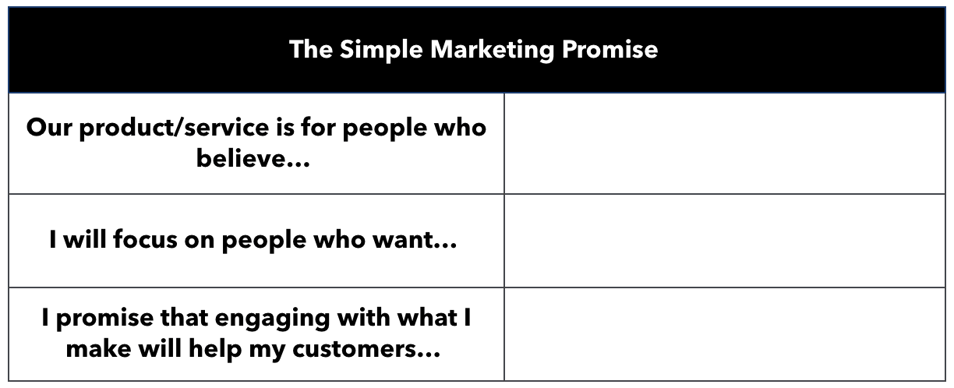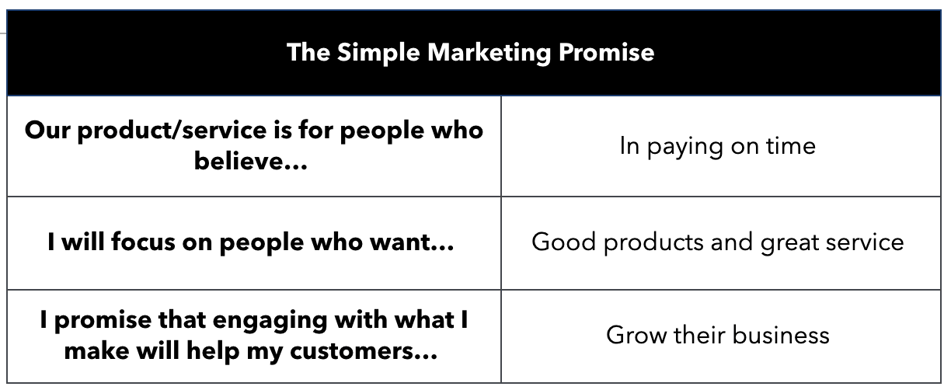
Purposeful Marketing Method: Great Customers – Yours and Theirs
By Austin LaRoche, ATAK Interactive CEO
Let me tell you a story about a woman named Maggie.
About six months after I moved to a neighborhood just north of Pasadena, I signed up for a boot camp. On the first day, I got paired in an exercise with a woman named Maggie. As we were rowing a band back and forth, I decided to make small talk to distract myself from the pain my out-of-shape body was feeling.
“So, what do you do?” I asked.
“I’m a Landscape Designer,” she said.
“How serendipitous!” I yelped. “I just bought a home that needs a LOT of landscaping work. Can I get your card?”
We set up a time for her to come to my house and take a look at what we were hoping to do. One morning, after another treacherous boot camp, she came by and I began explaining to her my vision for the yard.
“I want artificial turf in the front, so everything looks clean…”
“No, I wouldn’t recommend that.” She said. She went on to explain how her work is about using all-natural plants and grass with a strong emphasis on drought-tolerant species. It was clear that she was BRILLIANT when it came to this stuff. She knew every plant, how they would survive in my front and back yards, and had a million suggestions for other plants, flowers, and sod I had never heard of, Kurapia. Kurapia took less water and would give me everything I wanted.
I left the meeting deciding two things were true:
- Maggie was great at her job and there was a reason why she is one of the highest-reviewed landscape designers in my area.
- I was not going to be her customer.
Maggie has an incredible point-of-view. She’s a green thumb. She knows how to get the best plants to grow in the toughest places at the cheapest prices. She cares so much about her customers and her work. That is her priority.
My priority, however, was completely different. I work at a Creative Agency and I am obsessed with clean and sophisticated design. I think Kurapia and other plants look wild and out-of-whack. They are not at all a part of my vision. I wanted my Pinterest boards full of turf, rocks, and floating decks to come to life.
I love this example because it perfectly illustrates how to be a great business person through the lens of losing a customer. Maggie knows who she is, stands for something, and resonates with our neighborhood. As a result, she has a successful business. However, we don’t have the same priorities or shared beliefs, which means I’m drawn more to a competitor. And that’s okay, we see this with big brands all the time.
Starbucks is for yuppies. Dunkin Donuts is for the blue-collar worker. Yetis are an eco-friendly product for people who want their beer cold at a NASCAR race and their coffee warm while hunting in the winter. Patagonia makes eco-friendly clothing for people that share their love of nature and land conservation.
Having a point-of-view that resonates with a target market is not new in the B2C space. However, B2B has been a little slow to play catchup. A lot of this can be attributed to the number of niche industries we see in B2B, usually with a smaller pool of market share available.
But with competition consistently on the rise, businesses need to find a way to stand out in a crowd. The answer is to have the courage to have a point-of-view and identify Great Customers who share it.
Now let’s be clear what a point-of-view is and what a point-of-view is not.
A point-of-view in this prism simply means the brand has prioritized non-business factors that can be shared with an audience. Seth Godin uses this concept in his 2019 book, This is Marketing, using the phrase “people like us, think like this.” So this doesn’t mean your business should engage in some “MSNBC vs. Fox News” political battle. It just means that outside of business, your brand should cling to something that matters.
Let’s use a couple of examples in the B2B space to give you a better idea of the concept.
I have a client, YouBar, which is a leading contract manufacturer of protein bars. Companies come to them and YouBar formulates, develops, and packages the delicious protein bars you see on the shelves in Whole Foods, Trader Joes, and your local grocery store. They’re an industry leader and are consistently approached by leading breakfast brands of the past about creating a new bar for them.
Unfortunately for the old guard, YouBar is not interested in them.
YouBar is interested in innovation. As new food diets and trends emerge, they want to help their customers, the brands selling the Protein Bars in the stores, by supplying them with the most cutting-edge options available. They see the space as a frontier for innovators. They don’t believe that the consumer is looking for a new bar from a General Mills or a Kellogg’s, but rather, gets excited by the new. So they partner with these emerging brands and showcase to them the opportunities at hand. They have seen these startups grab market share for the past decade and don’t see things changing anytime soon.
They value innovation and the new, and so they work with companies trying to create the Protein Bar of the future as a result.
On the other hand, my agency, ATAK Interactive, has zero interest in working with startups, even when VC funded with a healthy budget. Startups utilize the old cliché “work fast and break stuff” and we’ve seen the amazing technological advances that have resulted with that mentality.
However, it’s not how we want to help companies market their products and services. We believe in laying a foundational strategy and helping companies pragmatically grow. We don’t want to break anything and we’re not in a hurry to have companies spend away a lot of money without knowing why they’re doing it.
Startups prioritize and value speed. We prioritize and value purpose. Neither of us is wrong, and that’s okay.
In the aforementioned This is Marketing by Seth Godin, he lays out the idea of the Customer Promise:

Part one of our “Great Customers” exercise is challenging businesses to fill this out honestly. I emphasize honestly because this is a much harder exercise for businesses to grasp. They constantly are looking for outs. If I gave the CFO the option to fill out this chart, here’s what it would look like:

And that’s why they’re the CFO and they should count all of our numbers and leave the storytelling and brand resonating to those of us that utilize the left side of our brain.
Taking a shortcut on this exercise is easy, but it doesn’t help businesses get where they need to get, which is admitting that there are certain types of customers that are GREAT customers, however, they are not your great customer.
Let’s repeat for all the business owners reading out there who are trying to skim over this part because they don’t want to believe it – “there are GREAT customers out there who are NOT your great customer.”
Before we make these stunned and saddened business owners identify who this person is, let’s really hone–in on what makes our Great Customer using the lens of the Customer Promise.
1: Our product/service is for people who believe…
For most brands, this does not need to be anything political or controversial. But we need to put a priority on something. What is it?
An IT company I did this exercise with decided their answer to this question was “people who believe that technology is an essential component to their business development.”
That makes sense. IT companies sell automation, efficiency, and security tools. If you think these are important, you’d align with them.
2: I will focus on people who want…
This takes “belief” one step ahead and brings in “ambition.” What does our target customer want? And again, avoid the easy cliché answer here. All businesses can say they want “to grow the company.” That’s a given. But why does this company exist in the first place? And what’s its grand purpose? Where is it headed?
3: I promise that engaging with what I make will help my customers…
This is a key component of this exercise. Part of running a great business is identifying where your product or service is the best solution. Ask yourself “who can we REALLY help better than our competition? And why is that?” Nobody likes admitting they aren’t the best answer to this question, especially when their company has the capability to fulfill the order.
But if you go to the “Mom Lens,” that is, pretend that the customer is your mother who you love deeply and only want to pair her with the best solution for her problem. Looking through that lens, where are you the answer? How will you help these types of customers?
When we add these all up, it becomes clear: we can identify the psychographics that makes up our GREAT customer. Regardless of Persona type, which focuses more on demographics, ALL customers we go after should share these three attributes.
Now comes the hard part: Identifying the GREAT Customer that is not yours.
For this, we flip the Customer Promise on its head:

Uh oh. Now it gets hard. Let’s go back to our old friend, the CFO, to identify the “cop-out” way of answering this:

What’s the big problem with these answers? These characteristics don’t make a Great Customer. They make a very, very bad customer. They’re rude and don’t want to pay full price.
But there’s plenty of customers out there that are great that are not yours. Before we dissect the questions, let’s be clear on the purpose of this exercise: understanding how to build a stronger brand by identifying who does and who does not resonate with your beliefs. This does not mean that any successful company with strong relationships should fire a great customer that doesn’t fit this exercise to a T. It means that we will move forward trying to connect with our Great Customer and not waste time chasing someone else’s Great Customer. Is that clear? Good, let’s start the breakup process…
1: Our product/service is NOT for people who prioritize…
Thinking of your shared beliefs from the first part of the exercise, you can see that there’s a thread between your beliefs and your priorities. What is the opposite of that?
Using our IT company as an example, if they resonate with people who believe in the role of technology with business development, then it’s fair to say that the Great Customer who is not theirs prioritizes efforts other than operational efficiency for their growth. Or maybe they just prioritize everything above technology until their computer stops working and they need to be bailed out.
When you dig deep, you realize that the priority of the Great Customer who is theirs is proactive with their technology needs where the Great Customer who is not theirs is more reactive. Reactive clients pay bills on time, they have computers that break down, and they can be perfectly nice when troubleshooting a problem. But for this IT company that believes so deeply in the opportunity of using technology as a biz dev tool, they recognize that the reactive client takes a lot of the time to troubleshoot the kind of problems they are proactively avoiding with their Great Customer.
2: I will AVOID people who want…
Are our ambitions aligned? Do we both see the Promised Land as the same place?
This is a good opportunity to go back to the idea of the customer as the hero and you as the guide. If Luke Skywalker’s ambition is to go somewhere Yoda can’t guide him to, then there’s probably a better guide for Luke, right?
Think about where a Great Customer may want to go that isn’t the Promised Land you can help guide him or her. Again, no cop-outs. Different directions don’t mean one direction is bad, it just means it’s different.
3: I can’t help customers that are hoping to…
You’re not as good for this customer as one of your competitors. Admit it. It will set you free and help you run a more honest and effective operation. I’ll give you an example.
I’ve recently explored the idea of building a sales team. I sat down with a sales consultant whose company prides itself on being able to build out effective sales teams. He asked me a bunch of questions about my operation before politely telling me his company could not help.
They were more geared for SaaS sales, not services, typically coming in when a team had at least three reps and needed additional support and structure.
How did I react to that? It made me love the guy. We spoke for another hour or two and he led me to resources and vendors much more in line with what I need. If I ever get the chance to send him business, I’ll do it in a heartbeat.
And that’s the magic here. By identifying the Great Customers that are yours and those that are theirs, you’re creating an authentic business that makes you 1000x more likable. You are being realistic about who you can help and setting your company up to have success when you do get the customer. You’re building trust with your team and your prospects by being clear about your capabilities and strengths.
Trust, authenticity and a point-of-view that resonates will give you the bump you need against the rising competition. You’ve got the opportunity, now you need the courage to go through this exercise and break up with a Prospect Archetype you’ve long known you needed to walk away from. Be bold, be brave, and most importantly, be honest with your company and who you can help.
Related Posts

Marketing Strategy Agency Derivatives and Growth Unlocked
Marketing is an essential aspect of any business. It can help increase brand awareness, attract new customers, and drive sales. However, developing an…

Boosting ROI: Benefits of Hiring a Marketing Strategy Agency
Are you looking for ways to enhance your marketing strategy and increase your returns? Look no further than Derivatives, a top-tier marketing strategy…

The Role of a Web Design Agency in Boosting Your Online Presence
We examine the field of web design and the work of web designers in this blog. It takes a variety of talents, including graphic design, coding, and user…